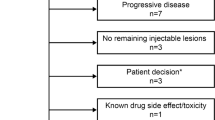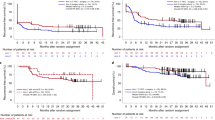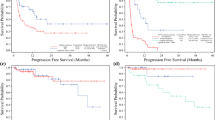Abstract
Background
Talimogene laherparepvec (TVEC) is an oncolytic herpes virus used as intralesional therapy for patients with unresectable stage IIIB through IV melanoma. We reviewed the standard of care treatment of TVEC at a single institution.
Methods
All patients treated with TVEC for advanced melanoma were retrospectively evaluated from 2015 to 2018. Patient demographics, clinicopathologic characteristics, treatment response, and toxicity were reviewed.
Results
Twenty-seven patients underwent therapy with TVEC. Median age was 75 years, and 63% of patients were female. Seventeen (63.0%) patients underwent injections on the lower extremity, four (14.8%) on the upper extremity, four (14.8%) on the head and neck, and two (7.4%) on the trunk. Median number of injections was five. Median follow-up was 8.6 months. Of the 27 patients, 23 patients met the criteria for response analysis with at least 8 weeks follow-up. Ten (43.5%) patients experienced a complete response (CR), three (13.1%) experienced a partial response (PR), and five (21.7%) had stable disease (SD) for an overall response rate of 56.5% (CR + PR) and a disease control rate of 78.3% (CR + PR + SD). Adverse events were mostly limited to mild constitutional symptoms within 48 h of injection. Two patients developed cellulitis treated with oral antibiotics, and one patient underwent excision of a lesion for ulceration and bleeding during therapy.
Discussion
TVEC is an effective and well-tolerated intralesional therapy for patients with unresectable stage IIIB through IV melanoma. A CR was achieved in almost half of patients treated. Disease control is seen in the vast majority.


(Top row images previously published in: Miura JT, Zager JS. Intralesional therapy as a treatment for locoregionally metastatic melanoma. Expert Rev Anticancer Ther. 2018;18(4):399–408)


Similar content being viewed by others
References
Amin MB, Edge S, Greene F, et al. AJCC Cancer Staging Manual, 8th edn. Berlin: Springer; 2017.
Borgstein PJ, Meijer S, van Diest PJ. Are locoregional cutaneous metastases in melanoma predictable? Ann Surg Oncol. 1999;6(3):315–21.
Pawlik TM, Ross MI, Johnson MM, et al. Predictors and natural history of in-transit melanoma after sentinel lymphadenectomy. Ann Surg Oncol. 2005;12(8):587–96.
Weitman ES, Perez M, Thompson JF, et al. Quality of life patient-reported outcomes for locally advanced cutaneous melanoma. Melanoma Res. 2018;28(2):134–42.
Hodi FS, O’Day SJ, McDermott DF, et al. Improved survival with ipilimumab in patients with metastatic melanoma. N Engl J Med. 2010;363(8):711–23.
Robert C, Long GV, Brady B, et al. Nivolumab in previously untreated melanoma without BRAF mutation. N Engl J Med. 2015;372(4):320–30.
Thompson JF, Kam PC, Waugh RC, Harman CR. Isolated limb infusion with cytotoxic agents: a simple alternative to isolated limb perfusion. Sem Surg Oncol. 1998;14(3):238–47.
O’Donoghue C, Perez MC, Mullinax JE, et al. Isolated limb infusion: a single-center experience with over 200 infusions. Ann Surg Oncol. 2017;24(13):3842–9.
Read TA, Smith A, Thomas J, et al. Intralesional PV-10 for the treatment of in-transit melanoma metastases: results of a prospective, non-randomized, single center study. J Surg Oncol. 2018;117(4):579–87.
Miura JT, Zager JS. Intralesional therapy as a treatment for locoregionally metastatic melanoma. Expert Rev Anticancer Ther. 2018;18(4):399–408.
Robert C, Schachter J, Long GV, et al. Pembrolizumab versus ipilimumab in advanced melanoma. N Engl J Med. 2015;372(26):2521–32.
Larkin J, Hodi FS, Wolchok JD. Combined nivolumab and ipilimumab or monotherapy in untreated melanoma. N Engl J Med. 2015;373(13):1270–1.
Chapman PB, Hauschild A, Robert C, et al. Improved survival with vemurafenib in melanoma with BRAF V600E mutation. N Engl J Med. 2011;364(26):2507–16.
Dahlman KB, Xia J, Hutchinson K, et al. BRAF(L597) mutations in melanoma are associated with sensitivity to MEK inhibitors. Cancer Discov. 2012;2(9):791–7.
Kohlhapp FJ, Kaufman HL. Molecular pathways: mechanism of action for talimogene laherparepvec, a new oncolytic virus immunotherapy. Clin Cancer Res. 2016;22(5):1048–54.
Hercus TR, Thomas D, Guthridge MA, et al. The granulocyte-macrophage colony-stimulating factor receptor: linking its structure to cell signaling and its role in disease. Blood. 2009;114(7):1289–98.
Andtbacka RH, Kaufman HL, Collichio F, et al. Talimogene laherparepvec improves durable response rate in patients with advanced melanoma. J Clin Oncol. 2015;33(25):2780–8.
Balch CM, Gershenwald JE, Soong SJ, et al. Final version of 2009 AJCC melanoma staging and classification. J Clin Oncol. 2009;27(36):6199–206.
World Health Organization. WHO handbook for reporting results of cancer treatment. Geneva: World Health Organization; 1979.
Therasse P, Arbuck SG, Eisenhauer EA, et al. New guidelines to evaluate the response to treatment in solid tumors. European Organization for Research and Treatment of Cancer, National Cancer Institute of the United States, National Cancer Institute of Canada. J Natl Cancer Inst. 2000;92(3):205–16.
Couture J. Melanoma: the management of local recurrence and in-transit metastasis. Canadian J Surg. 1982;25(6):698–700.
Thompson JF, Agarwala SS, Smithers BM, et al. Phase 2 study of intralesional PV-10 in refractory metastatic melanoma. Ann Surg Oncol. 2015;22(7):2135–42.
Beasley GM, Caudle A, Petersen RP, et al. A multi-institutional experience of isolated limb infusion: defining response and toxicity in the US. J Am Coll Surg. 2009;208(5):706–15. (discussion 715–7).
Kroon HM, Coventry BJ, Giles MH, et al. Australian multicenter study of isolated limb infusion for melanoma. Ann Surg Oncol. 2016;23(4):1096–103.
Larkin J, Ascierto PA, Dreno B, et al. Combined vemurafenib and cobimetinib in BRAF-mutated melanoma. N Engl J Med. 2014;371(20):1867–76.
Hurwitz AA, Yu TF, Leach DR, Allison JP. CTLA-4 blockade synergizes with tumor-derived granulocyte-macrophage colony-stimulating factor for treatment of an experimental mammary carcinoma. Proc Natl Acad Sci USA. 1998;95(17):10067–71.
van Elsas A, Hurwitz AA, Allison JP. Combination immunotherapy of B16 melanoma using anti-cytotoxic T lymphocyte-associated antigen 4 (CTLA-4) and granulocyte/macrophage colony-stimulating factor (GM-CSF)-producing vaccines induces rejection of subcutaneous and metastatic tumors accompanied by autoimmune depigmentation. J Exp Med. 1999;190(3):355–66.
Puzanov I, Milhem MM, Minor D, et al. Talimogene laherparepvec in combination with ipilimumab in previously untreated, unresectable stage IIIB-IV melanoma. J Clin Oncol. 2016;34(22):2619–26.
Author information
Authors and Affiliations
Corresponding author
Ethics declarations
Disclosures
JSZ, consultant, Amgen; speaker bureau, Amgen; research funding, Amgen; AAS, research funding, Amgen; MCP, research funding, Amgen.
Rights and permissions
About this article
Cite this article
Perez, M.C., Miura, J.T., Naqvi, S.M.H. et al. Talimogene Laherparepvec (TVEC) for the Treatment of Advanced Melanoma: A Single-Institution Experience. Ann Surg Oncol 25, 3960–3965 (2018). https://doi.org/10.1245/s10434-018-6803-0
Received:
Published:
Issue Date:
DOI: https://doi.org/10.1245/s10434-018-6803-0




